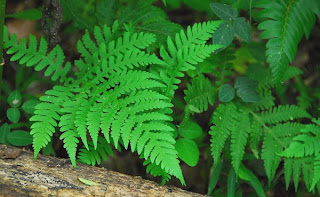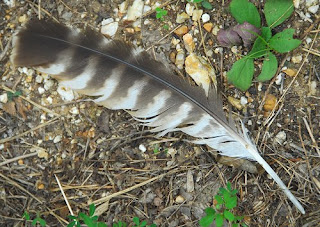
(Photo: Making the first crux move just off the deck on Absurdland (5.8).)
The day after Thanksgiving is often a great day in the Gunks. The weather is frequently cooperative, and the cliffs are always pretty empty.
This year we had a great time, climbing in shirtsleeves and light jackets, although it was a bit chilly when we first set out. Gail and I climbed in a party of three with Julia, a friend of Gail's with whom I hadn't climbed before. During the drive up, I found out that Julia is a lot like me, working through all the classic 5.9's in the Gunks and setting her sights on the 5.10's.
I knew this might well be my last day of climbing in , so I hoped to get on at least one 5.10.
But first we had to find a good warm-up climb. I suggested Absurdland (5.8), a great single-pitch route I hadn't been on in . I had taken a brief hang at the second crux way back in when I led the climb onsight, and didn't go back until , when I easilyfollowed Maryana up it. I really enjoyed it last year and wanted to go back to send it on lead, which I was confident was well within my abilities nowadays.
The climb reminds me of the first pitch of Son of Easy O (5.8). In both climbs the first 20 feet contain steep, somewhat thin moves up a crack, and then both climbs ease off to beautiful, lower-angled face climbing. On Absurdland the two crux moves come pretty fast off the ground. Both moves are well-protected and maybe a little stiff for 5.8. (The climb has at times been rated an easy 5.9.)
I had no trouble with the cruxes this time around, though I could see why I took that hang back in . The second crux is pumpy and if you aren't confident enough to move right away it is difficult to arrange a rest stance there. There is good pro right at your chin so my advice is that you just go for it! After that move it's all gravy.

(Photo: Julia starting up Gory Thumb (5.9).)
Absurdland ended up setting the agenda for the rest of the day. Everything else we did was nearby.
Julia picked Gory Thumb (5.9) for her first lead. I was glad she selected it because I'd never done it before. I had looked at it and rejected it because it seemed like a squeezed-in route (next to Raunchy and Wild Horses) without too much too offer. I thought the crux thin crack on the white face about 40 feet up would be over in one move, and that the rest of the climb would be a waste of time. Also I was concerned about the pro down low.
But Julia found a really good nut right after the start. (I struggled to remove it.) And I ended up enjoying the pitch. The initial moves are much easier than 5.9 but they are interesting. Up above, the crux is good and well-protected with small wires. You can finish as Julia did by continuing straight up above the crack to an easy fault, or you can contrive to prolong the real climbing by stepping left and making a couple of slab moves up to the ledge, which is what I did (at Gail's suggestion) as the second. Nice pitch. Maybe a touch easy for 5.9? Swain has it as 5.8+.

(Photo: Thin moves right from the jump on Never Never Land (5.10a).)
After Gory Thumb it was my turn to lead again and I knew exactly what I wanted to do. My objective was so close, drawing me like a magnet.
Balrog! Balrog! Balrog!
This climb has been on my list all year, which might seem strange because no one thinks it is an "easy" 5.10. At 5.10b many call it a sandbag. The crux is very unusual, featuring a hanging, sloping corner. You have to find a way to reach up to the holds high in the corner (which plays out like a roof problem), and then find some way to get yourself onto the odd, sloping left wall of the corner. But even though this crux is challenging, it is short, and there is an awesome horizontal crack-- it resembles a mail slot-- for pro right at the crux roof. It is a clean fall into the air if you fail. I figured that even if the crux was too hard for me to onsight I should be able to protect it well.
Why not go for it?
I dispensed with the easy early climbing quickly, placing very little gear. Then I found myself at a slab beneath the looming roof. In this slab was a perfect thin vertical seam. Up close, the crux roof looked much scarier than it did from the trail. There was a great-looking undercling hold in the roof and from there I figured I could reach the mail slot on the left side of the hanging corner and throw in a piece. But if I was wrong and fell reaching for the slot I might tumble awkwardly down the slab. I hesitated quite a bit, placing a nut in the seam, then thinking about the move, and then repeating the whole process.
I ended up placing four (!) nuts in the slab before I finally went for it.
I needn't have worried so much about reaching the mail slot. That part turned out to be no problem.
But I struggled with the crux reach afterward, taking a few hangs before I figured the whole thing out. I had great gear. Ultimately I had two cams in the mail slot, a purple Camalot that was solid if a little shallow and a bombproof red Totem Basic (Alien clone). If you place two cams as I did, make sure to leave some room for your hand and a later toe!

(Photo: Julia on Never Never Land (5.10a), before the crux.)
I was disappointed that I didn't onsight Balrog, but I'm pretty sure I can redpoint it in , so long as I nail the reach after the mail slot to the great hold up in the corner. There is no magic to this reach, you just need the confidence that comes from knowing how bomber the hold is. The subsequent move to the left wall is strenuous, but I think I have it all worked out. I will not spell it all out but I will tell you the secret to my beta:
Sometimes, grasshopper, it is better to push than to pull.
I'm not sure but I suspect I might be doing Balrog the hard way.Dick Williams says in his guidebook that the climb is especially rewarding if you can figure out the easier way to do it. After I got back down, Julia struggled with Balrog much as I did, and then Gail schooled the both of us by sailing up it like it was nothing. I was belaying and couldn't quite tell what she did, but it looked very different from my solution. If you are searching for the especially rewarding easy way to do it I'd suggest you reach out to Gail. She knows.
Note: If you are heading up Balrog in the near future, bring some new webbing. The two pieces of webbing that were tied to the belay tree there in late November were both feeling pretty brittle. We went ahead and used the station but in retrospect I wish we'd replaced the webbing.

(Photo: More of Never Never Land (5.10a), juuust beneath the crux.)
Julia was pissed off about Balrog, and she was on a mission for redemption. She decided to get it by leading Never Never Land (5.10a).
This was her first 5.10 lead and I was honored to witness it. Although Never Never Land has an easier rating than Balrog, I think Never Never Land is a much headier lead, with spaced pro and far more sustained climbing.
Gail and Maryana have been pushing me to lead Never Never Land, but I have resisted, both because this kind of thin face climbing isn't my favorite thing and also because in the summer of I toproped it with Gail and (to my enduring shame) I couldn't do the crux move AT ALL. It was a very hot, slimy day, and at the time, in those conditions, I couldn't imagine doing the move cleanly. The crux crimpers were so greasy, the footholdsnonexistent.On that day I fell several times and then gave up, French-freeing the move by pulling on the draw at the bolt.
This time around I was excited to follow Julia up Never Never Land so I could check it out in better conditions without having to lead the climb. I'm afraid that watching her did not make me want to jump on the sharp end. There is a repeated pattern of hard moves above gear that lead to the stances where one can get pro. A fall at any one of these difficult moves would not be horrible, but would send you for a ride. There are one or two such moves before the crux. Then the crux move just after the bolt is well-protected, but you have to run it out to the piton at the next horizontal, which is quite a ways away. Right before the piton is another hard move. After the piton it eases off a touch and the final moves have better pro but it isn't easy by any stretch. The thin face moves continue all the way to the chain anchors.

(Photo: Julia just past the crux of Never Never Land (5.10a). Big crimpin'! Way to go!)
Julia did a great job, handling the whole thing with a calm intensity. There were some tense moments, but she made it to the top without a fall, elated. When it was my turn, I was pleased to send it on toprope. Still I worry about leading it, as there are at least three places where I can see myself falling off if things don't go just right. Whether on lead or on toprope, I should really do more of this type of thin face climbing. All the way up I kept telling myself (and others!) that I hated the climb, but by the time I reached the chains I had to admit I loved it just a little.
We ended our day with a warm-down. I led Cakewalk (5.7), another nearby classic that usually sees action only on its first pitch, which ends at a bolted chain anchor. On my last and only previous trip up Cakewalk I'd gotten lost and wandered into some much more difficult and poorly-protected climbing, from which I'd thankfully emerged unscathed. This time I made sure to go left immediately after the tree and it was nothing but joy. Some nice face climbing wanders up to the obvious, huge right-facing corner. Dick describes the first part of the pitch as a little run out but I found plenty of pro. Then the burly moves up the corner were great fun. Before I knew it I'd reached the chains. The climb, like , was over much too soon.
 The 3rd reunion of the Phend - Fisher families met at Frank Wehrleys on June 24 - 1911
The 3rd reunion of the Phend - Fisher families met at Frank Wehrleys on June 24 - 1911 Today was the 12th anniversary of my 30th birthday. And it was Aric's 19th birthday. So we put on our party hats and went and had some family fun. The guys went hiking again this morning. I was going to go, but my best friend saved me. (thanks again!) So I slept in and read books. Heavenly!
Today was the 12th anniversary of my 30th birthday. And it was Aric's 19th birthday. So we put on our party hats and went and had some family fun. The guys went hiking again this morning. I was going to go, but my best friend saved me. (thanks again!) So I slept in and read books. Heavenly!


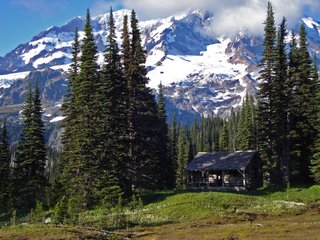 The snowpack is rapidly melting, which allows for quick and easy access to the alpine. Most of the Wonderland Trail, for instance, has melted out (save Panhandle Gap area.) The meadows are in full bloom, yet the upper mountain still has a fair amount of winter snowpack. Time to climb...
The snowpack is rapidly melting, which allows for quick and easy access to the alpine. Most of the Wonderland Trail, for instance, has melted out (save Panhandle Gap area.) The meadows are in full bloom, yet the upper mountain still has a fair amount of winter snowpack. Time to climb...
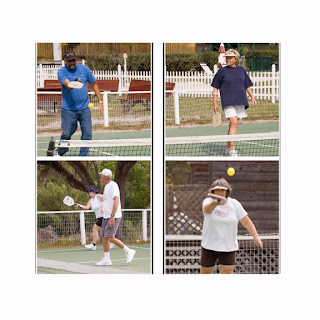
 yet another new 'unofficial' round trip summit speed record, please read on. For the rest of you who are tired of hearing of such drivel, we suggest you continue reading anyway and perhaps you still may find the story interesting. Besides, h
yet another new 'unofficial' round trip summit speed record, please read on. For the rest of you who are tired of hearing of such drivel, we suggest you continue reading anyway and perhaps you still may find the story interesting. Besides, h Friday afternoon it clouded up and I thought for sure we would get a good shower but we didn't. We did get to see a part of a rainbow in a really dark cloud.
Friday afternoon it clouded up and I thought for sure we would get a good shower but we didn't. We did get to see a part of a rainbow in a really dark cloud.



 Teton National Park. The view from the Glacier View Turnout.
Teton National Park. The view from the Glacier View Turnout. First there were Buffalo. Not a big herd though, just a few scattered about.
First there were Buffalo. Not a big herd though, just a few scattered about.
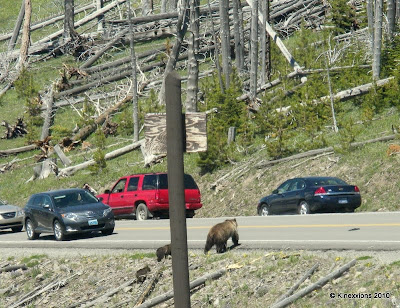 Then there were Bears! Mama bear and her two cubs came up from the valley and crossed the highway, blissfully ignorant of the chaos and confusion they were causing! These pictures were taken through the windshield with the zoom at maximum magnification. I was about 15 vehicles away from the action.
Then there were Bears! Mama bear and her two cubs came up from the valley and crossed the highway, blissfully ignorant of the chaos and confusion they were causing! These pictures were taken through the windshield with the zoom at maximum magnification. I was about 15 vehicles away from the action.
 There was also a moose (at least, that's what I think it was) with a large rack of antlers. I didn't get a picture of it though.
There was also a moose (at least, that's what I think it was) with a large rack of antlers. I didn't get a picture of it though.